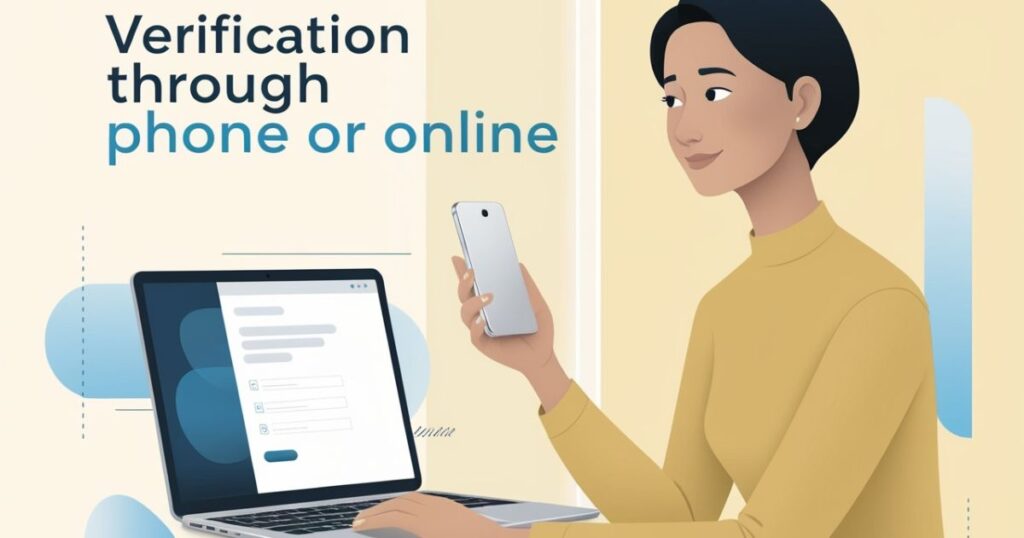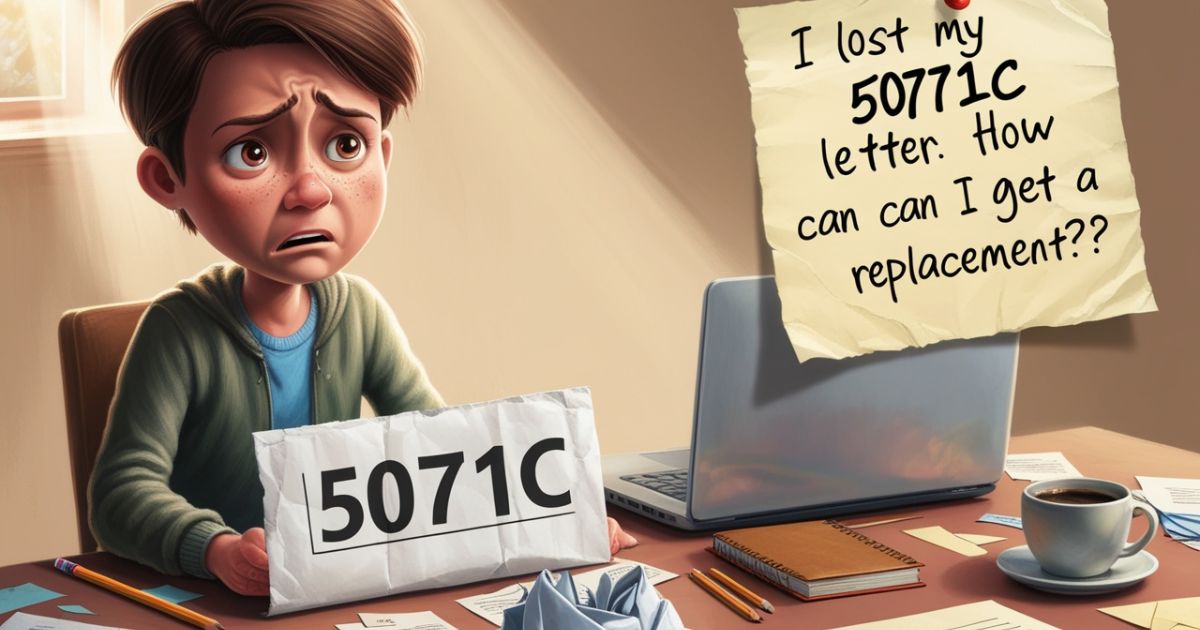Learn how to obtain a replacement for your lost 5071C letter with simple steps for verification and the necessary information you’ll need.
When the IRS (Organization) sends you a 5071C letter, it’s requesting that you verify your identity to prevent potential identity theft (Crime/Fraud) and protect your tax refund (Financial Term).
Unfortunately, these important documents can sometimes be misplaced or lost before you’ve had a chance to respond. If you’ve found yourself saying, “I lost my 5071C letter,” don’t worry—this comprehensive guide will walk you through the process of addressing this situation efficiently and effectively.
Understanding the 5071C Letter
The 5071C Letter (Document) is an identity verification request sent by the Internal Revenue Service when they detect potential suspicious activity related to your tax return (Financial Term).
This letter is part of the IRS identity verification process designed to combat the rising instances of tax-related fraud. When the IRS notices patterns that might indicate someone else filed a return using your information, they’ll send this letter and hold your refund until your identity is confirmed.
It’s important to understand that this letter isn’t indicative of an audit or suggestion of wrongdoing on your part. Rather, it’s a protective measure implemented by the IRS to ensure that your tax information and potential refund aren’t compromised by fraudulent activity.
The letter typically requests that you verify specific information from your tax return and personal details that only the legitimate taxpayer would know.
The IRS security measures 2024 have been enhanced in response to sophisticated fraud attempts, making these verification letters increasingly common. If you’ve lost your 5071C letter, it’s crucial to address the situation promptly to avoid delayed tax refund due to identity issues.
Requesting a Duplicate Letter
If you’ve misplaced your 5071C letter (Document), the most direct approach to resolve this issue is contacting the IRS directly. Call the designated IRS identity verification number, 1-800-829-1040 (Phone Number), during regular business hours.
Be prepared for potential wait times, especially during peak tax filing season (January through April). When connected with an IRS representative, explain that you’ve lost your 5071C letter and need guidance on completing the identity verification process.
While the IRS doesn’t technically provide duplicate letters, the representative will access your account information and guide you through the necessary steps to complete the verification process without the original document.
To facilitate this conversation, have your Social Security Number (Personal Information), filing status (Financial Term), and the exact amount reported on your most recent tax return readily available.
For those who prefer alternative methods, the IRS also offers the Get Transcript (Service) feature on their website. While this won’t provide a direct copy of the 5071C letter, it gives you access to your tax account information, including records of notices sent to you.
This can help confirm what verification is needed and provide details required to complete the process. The table below outlines what you’ll need for the request duplicate IRS letter process:
| Information Required | Why It’s Needed | Where to Find It |
| Social Security Number | Primary identifier for your tax account | Personal records, Social Security card |
| Filing Status | Verifies your return information | Your most recent tax return |
| Exact Amount on Latest Return | Security verification question | Line 15 on Form 1040 (2023 return) |
| Mailing Address | To confirm your current contact information | Your personal records |
| Date of Birth | Identity verification | Personal identification |
Verification Through Phone or Online

The IRS offers multiple pathways to complete the IRS 5071C verification process even if you’ve lost the original letter. The two primary methods are through phone or the online Identity Verification Service (Service).
For online verification, visit the official IRS website and locate the Identity Verification Service. This secure platform will guide you through a series of questions about your personal and financial history to confirm your identity.
To begin, you’ll need to create an account by providing your email address, creating a username, and establishing a secure password. Once your account is set up, the system will prompt you to enter your Social Security Number (Personal Information) and specific details from your most recent tax return (Financial Term).
The online verification process typically includes questions about your:
- Personal information (address history, date of birth)
- Financial accounts (mortgages, loans, credit cards)
- Recent tax filing information
- Other details that only the legitimate taxpayer would know
For those who prefer telephone verification or encounter issues with the online system, the IRS phone verification process remains available. Call 1-800-829-1040 (Phone Number) and follow the automated prompts to reach an identity verification specialist.
The representative will ask a series of questions to confirm your identity and note in your account that verification has been completed. Both methods accomplish the same goal—confirming your identity and allowing your tax return processing to proceed.
The online option typically offers more convenience and avoids potential hold times, while the phone option provides direct assistance from an IRS representative who can address any specific questions you might have during the process.
Read This Post: 846 Refund Issued but Not Received? Here’s What to Do
Information You May Need
Successfully completing the taxpayer identity confirmation process requires specific information that demonstrates your knowledge of your recent tax filings and personal details. Being prepared with this information will make the verification process much smoother and more efficient.
The IRS has strengthened its verification requirements in response to sophisticated fraud attempts. You should be familiar with details from your Form 1040 (Document) and associated schedules.
For 2024 (Date/Year), accuracy in reporting your income (Financial Term), deductions (Financial Term), and credits (Financial Term) is particularly important when responding to verification questions.
Beyond your tax return information, be prepared to answer questions about:
- Your filing history (dates and methods of past returns)
- Employment information (current and previous employers)
- Loan account numbers and payment amounts
- Credit card accounts and approximate payment amounts
- Property tax information if you own real estate
- Driver’s license or state ID information
The IRS uses these details to create a verification profile that would be difficult for an identity thief to replicate. Having your complete tax records accessible during the verification process will allow you to answer these questions accurately and confidently.
Providing incorrect information can further delay your refund or require additional verification steps.
What to Do After Verification
Once you’ve successfully completed the IRS taxpayer authentication process, your tax return will resume processing. Typically, if your return qualifies for a refund, you can expect to receive it within 21 days from the date of successful verification, though complex returns may take longer.
To monitor the status of your return and refund, use the “Where’s My Refund?” tool on the IRS website or the IRS2Go mobile app. After verification, it’s advisable to implement additional security measures to protect your tax information.
Consider creating an Identity Protection PIN (IP PIN) through the IRS website, which adds an extra layer of security to your tax filing process. Additionally, reviewing your credit reports regularly can help you detect any suspicious activity potentially related to tax identity theft.
Preventing Future Issues
Implementing proactive measures can help you avoid tax refund delays and streamline future interactions with the IRS. Maintaining organized digital or physical copies of all IRS correspondence is essential.
Consider scanning important tax documents and storing them securely in digital format with appropriate backup procedures. Ensure that the IRS has your current address on file by submitting
Form 8822 if you move. This helps guarantee that important notices reach you promptly. Additionally, filing your tax return early in the season can reduce the risk of an identity thief filing a fraudulent return using your information before you submit your legitimate return.
Staying informed about current tax laws (Legal Term) and IRS security measures 2024 will help you navigate the tax filing process more efficiently and reduce the likelihood of identity verification delays.
FAQ’s
What do I do if I lost my 5071C letter?
Contact the IRS at 1-800-829-1040 (Phone Number) and explain you need to complete the identity verification process. Have your Social Security Number (Personal Information), filing status (Financial Term), and recent tax return information ready when you call.
What if I lost my IRS identity verification letter?
The process is the same regardless of which verification letter you received. Contact the IRS at 1-800-829-1040 (Phone Number), and they’ll guide you through verification over the phone or direct you to their online portal to complete the process.
What to do if I lost my IRS notice letter?
Access your online account at IRS.gov and check the “Tax Records” section to view recent notices. Alternatively, call 1-800-829-1040 (Phone Number) with your Social Security Number (Personal Information) and tax return details to learn about the notice’s purpose.
How do I get a copy of my IRS confirmation letter?
Use the Get Transcript (Service) on the IRS website to obtain account transcripts or records. For specific confirmation letters like installment agreements, call 1-800-829-1040 (Phone Number) or submit Form 4506-T by mail.

Hello, I’m Nadeem Sattar, a contributing editor at Opals Magazine. I navigate the intersection of Finance and Technology, delivering insightful analysis and forward-thinking perspectives. Join me on OpalsMAgazine.com for expert coverage of financial innovations, investment strategies, and emerging technologies reshaping our economic landscape.








